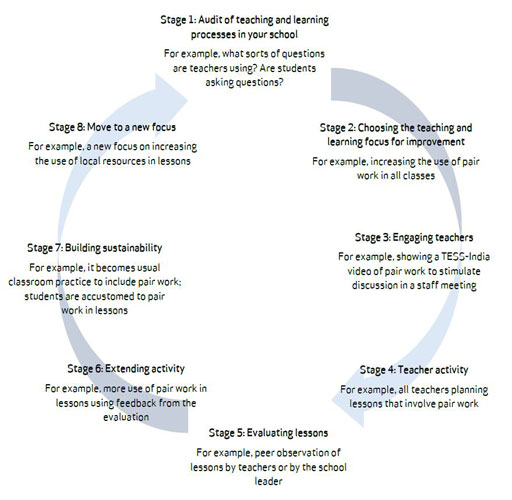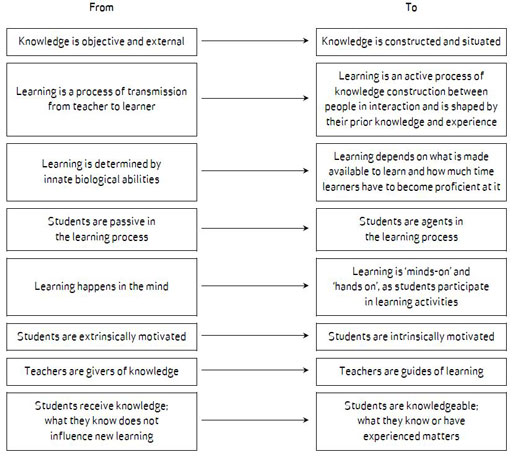Use 'Print preview' to check the number of pages and printer settings.
Print functionality varies between browsers.
Printable page generated Thursday, 20 November 2025, 9:53 PM
TI-AIE: Transforming teaching-learning process: leading improvements in teaching and learning in the secondary school
What this unit is about
This unit will help you to support your teachers to develop their practice and bring about pedagogical change in your school. Much has been written about this subject – and there has been training organised on such topics as ‘activity-based learning’ and ‘child-centred learning’ – but how do you actually put this into practice in your school? The unit gives practical examples of how to use the TESS-India Open Educational Resources (OERs) with teachers in your school to make their lessons more participatory in order to improve the learning outcomes of your students.
The unit guides you through a change project lasting one term (about 12 weeks) where you will focus on pedagogical change in your school. You will be encouraged to identify an aspect of your teachers’ classroom practices that you would like to change. There are activities for you to carry out in your school and case studies that offer examples of implementation.
You should read the whole unit before you start, and then do the activities in the order in which they are set out, keeping records of your plans, actions and reflections as you go through the term.
Learning Diary
During your work on this unit you will be asked to make notes in your Learning Diary, a book or folder where you collect together your thoughts and plans in one place. Perhaps you have already started one.
You may be working through this unit alone, but you will learn much more if you are able to discuss your learning with another school leader. This could be a colleague with whom you already collaborate, or someone with whom you can build a new relationship. It could be done in an organised way or on a more informal basis. The notes you make in your Learning Diary will be useful for these kinds of meetings, while also mapping your longer-term learning and development.
What the school leader can learn in this unit
- Familiarity with the pedagogy and structure of TESS-India OERs.
- To appreciate the potential for adapting and using OERs in your school.
- How to identify a focus to increase student participation in learning in your school.
- Ideas on how to sustain improvements in teaching and learning.
1 Enabling participatory, student-centred pedagogy
Back in 2005, the NCF made it clear that students’ participation in their learning is key to achieving best learning outcomes. Students should have the opportunity to:
- contribute ideas when learning
- talk about and discuss their thoughts and experiences
- relate what they learn in school to their everyday lives.
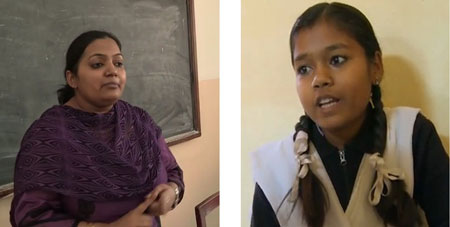
Research agrees with this. The reality is that implementation is difficult. Many teachers, particularly at secondary level, are convinced that factors such as large class size and the exam syllabus prevent them from being able to adopt more student-centred approaches. The TESS-India OERs provide practical examples – in the form of case studies and activities – for teachers to carry out in their classrooms to help them overcome these concerns.
In good schools, teachers themselves try to be active learners and reflect on their practice by regularly:
- examining what they do
- checking what is actually being learned by each student
- adapting and improving their classroom practices including their teaching skills
As a school leader, part of your role is to support teachers to experiment in their classrooms and reflect on their practice. When teachers see and experience participatory approaches to teaching, they will appreciate the benefits. Once they experience the benefits for themselves, teachers will gain confidence in adopting new approaches.
In Activity 1 you will consider the present teaching and learning in your school and choose a focus for improvement over the next few weeks. The following activities will then help you to support teachers in improving their classroom practice. This is illustrated in Figure 2.
Activity 1: How student-centred are your classrooms?
This activity asks you to examine how far student-centred teaching and learning already exists in your school. It is important to note where good practice is already happening because you can build on this.
Using the table in Resource 1, carry out an audit of current practices in your school. This is for your benefit, so you do not need to show it to anyone. You are looking for evidence of how many and to what extent teachers are enabling student participation in their classes. Be as honest as you can be.
You will come back to this audit in a later activity.
2 What is in the TESS-India OERs?
TESS-India has resources to support teachers in developing participatory approaches to learning. In this section and the next section, you will have a look at the resources available and select a focus for change (Stage 2 in Figure 2).
Resource 2 sets out the principles of the pedagogy for the TESS-India project and provides a useful summary of the changes (or learning movement) that the materials are designed to support.
Resource 3 lays out the actual content of the key resources and the different OERs. There are 15 OERs each in the areas of Secondary Science, Secondary English, and Secondary Maths, as well as a set of key resources with associated videos, all shot in Indian schools.
Activity 2: Looking at a TESS-India OER
Choose one TESS-India OER to look at in detail. If possible, do this activity with a senior colleague. The OERs have been designed to help teachers learn particular skills and competencies. As you read the TESS-India OER, have a look at Resource 4, which explains the structure of the OER. With your colleague, identify what the teacher will learn in each section of the unit.
Look at the TESS-India key resources. Which key resources does the OER refer to? If possible, watch the TESS-India videos that are linked to the OER.
Remember that the TESS-India OERs do not cover the whole student curriculum. They are designed to give teachers ideas that can easily be used or adapted for other topics.
3 What change should you lead?
You will now start to focus on one of the issues from your audit to bring about one improvement in teaching and learning your school. It is important not to try to improve too much at a time. By focusing on one issue at once, you are more likely to succeed.
Activity 3: Identifying your focus for improvement
Using your responses in Resource 1 and the list of participatory principles of practice in the TESS-India key resources (Resource 3), identify a single focus for change. (For example, this might be ‘pair work’ or ‘questioning’.)
You can see from the table in Resource 3 which TESS-India OERs and videos are linked to each principle of practice so that you can connect with all the relevant TESS-India resources. Make a list of the TESS-India OERs (Secondary Maths, Secondary English and Secondary Science) that you could use to help you develop this approach to teaching in your school.
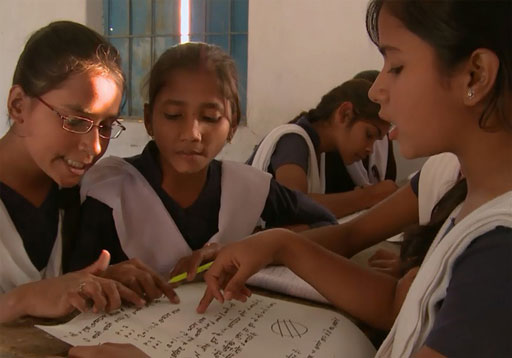
For example, you might know that your teachers do not think sufficiently about their lessons before class and therefore you choose to focus on planning lessons. This could lead to improvements not only in the way that lessons are structured, but also the variety of teaching methods and resources used. Alternatively, you might want students to talk more (see the key resource ‘Talk for learning’), or you might have big classes in your school and may decide that getting students to work in pairs (‘Using pair work’) helps teachers to teach large classes more effectively.
You can learn more about leading change in the OERs Planning and leading change in your school and Implementing change in your school.
It is important to choose a single focus in this term. If you try to change too much at once, the change will be less effective. Read the case study below to see how one school leader decided on her single focus.
Case Study 1: Mrs Chadha reflects on her findings
This is a Learning Diary entry written by Mrs Chadha, a secondary school leader who tried Activities 1 and 3 in her school.
I started filling in the table [in Resource 1] and it made me examine how I find out about what teaching is actually going on in the school. I realised that the information often comes from what teachers tell me during breaks, or from informal discussions. It made me think about perceptions: are the perceptions of the teachers the same as mine, or even the students?
I found that the key resources encouraged me to find a single focus for this term, as there seemed to be so much I didn’t know and so much to do. I believe that students asking questions helps their learning and I decided to go for a walk around the school to learn what questioning is going on in the lessons. Walking around the corridors during lesson time, it is easy to hear what is going on, as the doors are not closed due to the heat. I decided not to go into the classrooms, because I was concerned that the students and the teachers are not (yet) used to me doing that – the school leader entering could change what normally would happen in the classroom. So I listened from outside the classrooms.
What I noticed was that in most classes, the teacher was talking and the students listened silently. There was the occasional question from the teacher and the students chanted out the response together. But there were no open questions, or questions where students could disagree with what was said. The students were sitting in rows, all facing the board where the teacher was talking.
Only Mr Meganathan’s class was different – I heard him asking students a question where they had to disagree with him and explain their arguments. He also gave them ‘thinking time’ before they answered. I could hear students talking to each other about the questions and, looking through the window, I saw that they had turned to each other and were working in pairs.
It was clear that good practice was going on in Mr Meganathan’s classroom, but I knew I needed to be careful not to cause any resentment from other teachers if I publically singled him out for praise. I decided that I would make ‘questioning’ the focus for this term so that I could draw upon examples of Mr Meganathan’s participatory approach as well the TESS-India resources.
4 Working with your teachers
Part of your role is to work towards creating a learning environment for your teachers as well as your students, where teachers are encouraged to try out new ways of working and develop new skills. Teachers will find it difficult to do this unless you make them feel supported and safe to depart from old habits.
These are some ideas that heads of department had in one school to promote this ethos of learning through doing:
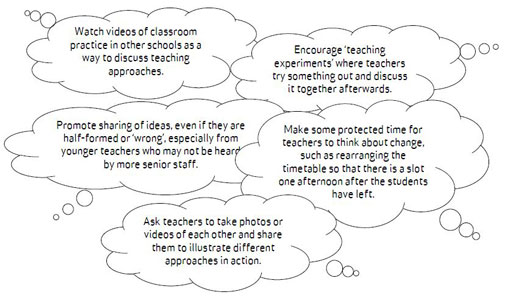
Having identified your focus, you need to engage your teachers in your plan. In the secondary context, it is good idea to start with your heads of department. Activity 4 suggests how you might introduce your idea to your heads of department and Activity 5 suggests how you might involve all the teachers.
Activity 4: Engaging your teachers
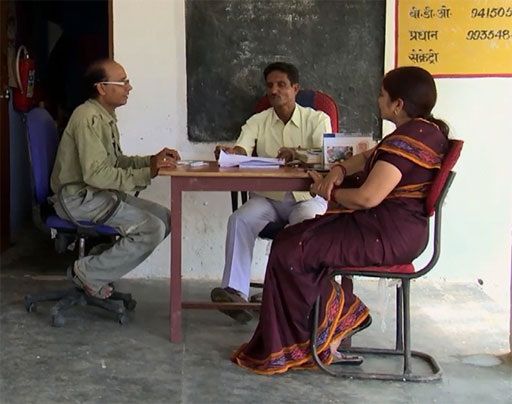
Working with your heads of department, share your idea for a focus on improvement in teaching and learning in your school. Together look at the related Secondary English, Secondary Maths and Secondary Science TESS- India OERs in detail. Remember, the activities can easily be adapted for other subject areas. But first, everyone needs to be familiar with the OERs and the approach.
Together, think about how your teachers will access the TESS-India OERs and how you will introduce them to the OERs. Here are some ideas from school leaders and heads of department:
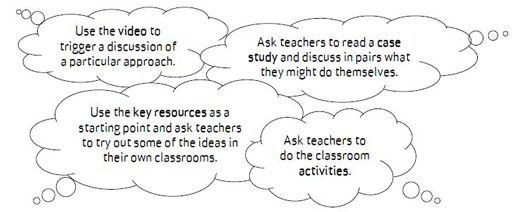
Now consider how you will engage your teachers to focus on change for the term: maybe as part of a staff meeting or as a training workshop? Think of your ‘story’ about the need for change. Remember you are to persuade and enable rather than order teachers to change their practices. Some of the things you might say are:
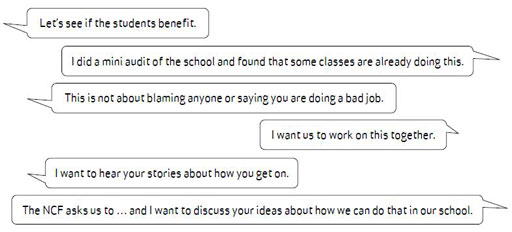
Think about how you might involve your teachers in selecting the OERs by finding out what topics they intend to teach this term and finding an OER that is relevant to that topic and demonstrates your chosen approach. You might share Resource 3 as a handout or put it up on your office wall.
If you can, show a TESS-India video and think about what discussions this could prompt. What questions might you ask or what activities might you ask your teachers to do? Think ahead about any questions you might get. Read Resource 5 on ‘possible difficulties’ so that you are prepared to answer questions that your teachers will raise.
Once you have introduced the idea, you could set a simple task for your teachers. You could ask them to work in pairs, acting as buddies for each other. Ask them to prepare teaching activities together using the OER and to then observe each other. They will need to schedule their lessons and you may be able to help by offering to teach their classes while they observe each other.
5 Sustaining a participatory approach
Whether you used the suggestion in Activity 4 or devised an alternative for your teachers, you need to monitor what is going on and evaluate whether your focus project is developing according to plan (Stage 5 in Figure 2). Such monitoring and evaluation activities can also inform what to do next and allow you to identify good practice or refine and adapt your plans.
You might well take on a coaching role with some teachers, or you may delegate this task to others who could do so. (There is another leadership unit on mentoring and coaching if you want to refresh your knowledge about this approach.)
Case Study 2: Mrs Chadha’s monitoring and evaluation
I was very curious to know how the teachers would go about developing their practice and use the TESS-India OERs. I encouraged the teachers to talk to me and others about their experiences, which gave me some insights into how things were going. Whenever I walk around the school now, I try to listen to what is being talked about, and who is talking in the classrooms.
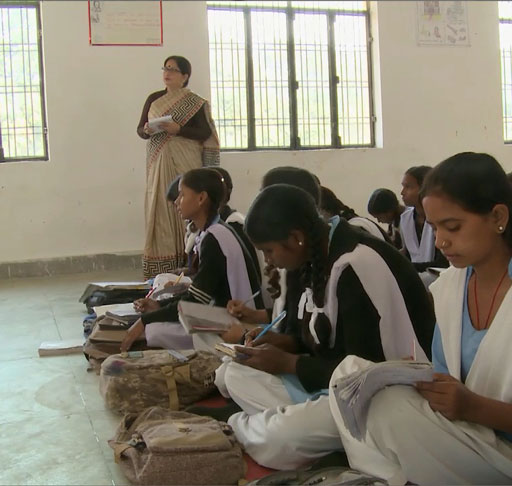
Over the weeks, I had noticed that Ms Chakrakodi’s classroom was subtly changing. She had already been using questioning to open the students’ minds, and was now working with another teacher to use the OERs to develop their practice, and they had told me this was going well. The subtle change was that she had developed a set of questions that made her students think about ‘what they knew’ and ‘why they were sure’.
I asked Ms Chakrakodi what had changed. She said that she was indeed trying to work on her questioning techniques in all her lessons. But she had noticed that thinking of good questions that would help her and the students assess what the students knew was hard to do in the midst of teaching. So she had started to write down possible questions before each lesson. Already she had established which sorts of questions worked best.
I made a note that at the next staff meeting that I would to ask Ms Chakrakodi and the others to share some of their best questions so that others could adopt them.
This case study shows how the school leader is not only monitoring what is going on, but ensuring that good practice is shared, encouraging more widespread adoption of new approaches. The next activity aims to help you keep the momentum going on your focus project.
Activity 5: Setting further tasks for your teachers
Start to think about your next staff meeting and how you could use it to review progress and set further tasks and goals for you and your teachers. Think about how you can prepare for the meeting so that you have maximum impact and teachers are not just talking to you.
You might ask teachers to work in pairs or small groups to discuss their experiences. Resource 6 has some questions you could use.
You could share your observations of good practice, taking care to share praise around. Teachers could be invited to share their success stories. You might even think about including feedback from students (anecdotal or through a survey).
Think about what teachers might do to further develop their skills with your teaching focus. What other support do they need? Are there other TESS-India OERs that might help? You should have some ideas ready, but listen to what they suggest and decide what to do next together.
Discussion
Your staff will be pleased to have their teaching recognised by you and other teachers. By holding a progress meeting you can recognise any positive changes, address any difficulties and keep your staff engaged. Enthusiastic and committed staff should be publicly praised. But remember that some staff will be more confident than others, so you should also praise small changes and offer additional support. Remember that you are modelling participative approaches where you value the exchange of ideas and experiences.
The next step is to consolidate good practice. In the next case study, school leader Mrs Chadha reflects on how she went about getting the changes established in her school.
Case Study 3: Using questioning to support learning becomes an everyday practice
Mrs Chadha was interviewed about how she embedded change in her school. Here she talks about the challenges that she faced and some of her strategies.
To be honest, I find embedding change the most challenging aspect of any project. It is so easy to tick it off and move on to the next project. I thought the only way to stop me from doing that was to write a plan for embedding the change, with dates for reviews, and to put it in my diary.
I was happy that all teachers had made some changes to their teaching, and I could hear more questioning taking place in the classroom to help learning. More varied questions were being asked and students were given more time to answer them. Some teachers were making major changes in many of their lessons; others did the occasional activity from an OER, often because they were prompted by their colleagues or by me.
I do not teach my own classes, but I was taking over the classes of the teachers who were going to observe each other. After a couple of these occasions I realised that they were also an opportunity for me to refresh my own teaching practice. As English is my teaching specialism, I asked a pair of English teachers whether I could join them in their task and they agreed. This made me realise how challenging the task was and how variable the teachers were in tackling it.
To keep up the momentum, I have now scheduled for the next two terms:
- monthly staff meetings to discuss progress
- times when the teachers can work together on planning for joint activities
- times when the teachers can go and observe each other (I am sure these will change, but at least there is a plan in place)
- a weekly ten- minute presentation by a teacher who talks about what they have been experimenting with.
I will continue to monitor progress.
With any change it is important to identify:
- and celebrate what has been learned
- what was challenging
- how the challenges were overcome
- what lessons were learned.
Activity 6: Celebrations and reflections

At the end of your term, you might organise a meeting to celebrate and acknowledge the hard work done on the focus issue in teaching and learning. In preparation for this you may want to go back to your Learning Diary and remind yourself of where you started. This meeting should not be a dry affair but should be interactive and participatory.
You could try using an ‘ideas wall’. This is a space on a wall where individuals can write ideas when they think of them, browse what others have written and add to others’ comments. It has the advantage of building over time and including everyone. To prompt teachers comments, you could for example put up large pieces of paper or pin small notes onto a board under the following titles:
- ‘What I have learned’
- ‘Changes in my teaching practice’
- ‘Changes in the learning behaviour of my students’
- ‘Changes in the learning outcomes of my students’
- ‘Challenges’
This should be a fun and invigorating activity, with staff standing rather than sitting, gathered around the ‘ideas wall’ (which might be a blackboard or large sheets of paper).
If you have a larger staff group, you could have different topics on different walls and ask staff to walk round and write their comments on the sheets of paper, and then discuss each sheet together. If you have Post-it notes, you could ask staff to write on them and then stick them on the appropriate sheet of paper. Another variation is to use paper tablecloths and ask staff to write on them as they sit in groups, moving from table to table.
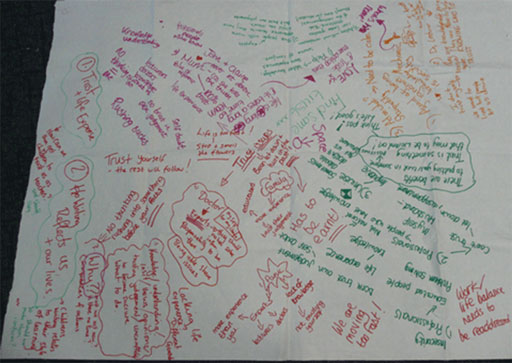
As with any brainstorming activity, you need to be able to summarise it and draw it together acknowledging contributions. You could leave the displays up afterwards, or have them typed up for future reference.
Discussion
It is important to capture the successes of your term’s focus project. Doing so means that:
- progress is acknowledged by all
- individuals are recognised for their achievements.
This can be a fun activity that generates a feeling of wellbeing and collegiality rather than being a formal meeting. Ideally you will listen more than you will speak. You can then take what you have heard and use the information to plan how to enable more participatory teaching in your school.
6 Summary
This unit has taken you through the process described in Figure 2. You are now familiar with the TESS-India OERs for secondary school teachers, and understand how they are structured and what components you might adapt and use in your setting. The OERs are free-standing and can be studied as a whole, but by now you will realise that they can be used flexibly to meet specific needs.
You may well have a strong vision for the sort of teaching and learning that you want to happen in your school. Your enthusiasm will be carried over to your staff if you can model the behaviours you are seeking and offer them support in experimenting with new ways of working.
The TESS-India OERs can support you in transforming teaching and learning in your school by giving you tools to develop and support your teachers in practical ways.
Resources
Resource 1: Audit of student-centred teaching and learning
| Statement | Related key resource | To what extent is this happening in my school? (Never, occasionally, sometimes, always) |
Examples of where this is happening (teacher, class, description) |
|---|---|---|---|
| Teachers plan lessons that involve a variety of teaching and learning approaches. | Planning lessons’ | ||
| Teachers use formative assessment in their classrooms | ‘Assessing progress and performance’ | ||
| Teachers monitor students’ work and provide individual oral and written feedback. | ‘Monitoring and giving feedback’ | ||
| Teachers use storytelling, role play and drama to interest students in learning. | ‘Storytelling, songs, role play and drama’ | ||
| Teachers use familiar local resources to support learning and relate the learning to everyday life. | ‘Using local resources’ | ||
| Teachers ask a variety of open questions that allow students to offer explanations and voice | ‘Using questioning to promote thinking’ | ||
| Teachers encourage students to talk together about their learning, as a whole class, in pairs, or in groups. | ‘Talk for learning’ | ||
| Teachers actively involve all students in the lessons. | ‘Involving all’ |
Resource 2: Principles of pedagogy
TESS-India aims to achieve transformational change for schools and teachers. The teacher development OERs are congruent with national policy aims. At the core of TESS-India is the student as an active learner and the teacher as the agent in their learning. The TESS-India OERs aim to move teachers away from more traditional practices and habits that make assumptions about learning and learners towards more empowering practice. They provide teachers with the ideas and tools to apply their learning to their practice, extending their repertoire and transforming their perception of the goals of education. The model of teacher change is about active experimentation and recognises the importance of teachers making mistakes and gaining enjoyment and motivation from challenging themselves.
The pedagogic shift (or learning movement) promoted by TESS-India Teacher Development OERs is summarised in Figure R2.1.
Resource 3: List of TESS-India key resources and OERs
- Planning lessons: For students to learn effectively, teachers need to plan activities that build on what their students already know. This key resource offers approaches and actions to take when lesson planning in order to advance students’ learning.
- Involving all: To ensure that all students have opportunities to participate in classroom activities, teachers need to know their students, what they know and how they know it. This key resource offers ideas for ways to make learning opportunities available to all students.
- Talk for learning: Creating opportunities for students to talk to one another and to their teacher is essential to support learning. Students share their understanding through talk and relate this to new learning. Talk is important for students of all ages. This key resource illustrates how teachers can organise opportunities for students to engage in productive talk in the classroom.
- Using pair work: Pair work enables students to learn from each other by negotiating what they understand and communicating it to each other. This key resource offers ideas of how pair work can be used effectively to support learning with students of all ages and in all subjects.
- Using open questioning to promote thinking: Asking good questions is a key skill for teachers. Open questions can prompt students’ thinking. Such questions also help teachers learn what their students know. This key resource gives teachers ideas to use different sorts of questions to extend their students’ thinking, while also listening carefully to their answers.
- Monitoring and giving feedback: This key resource encourages teachers to observe and guide student learning by listening carefully to student talk and the understanding they are developing from it before intervening with questions to prompt thinking.
- Using groupwork: Organising students to work in groups offers them opportunities to build on each other’s ideas and develop their understanding. This key resource offers some ways that teachers can organise students into groups for different activities.
- Assessing progress and performance: Assessment of student progress provides teachers with the evidence that they need to plan the next learning opportunity for each of their students. This key resource explains different types of assessment and examines how assessment can be undertaken before, during and after instruction.
- Using local resources: Resources can create authenticity in activities by making learning familiar and meaningful to students. Resources help students to move from objects (such as segments of fruit and counters) to symbols (such as numbers or fractions) in ways that make sense to them. Using resources creatively thus makes learning activities more motivating and relevant to students.
- Storytelling, songs, role play and drama: This key resource offers examples of how teachers can use storytelling, songs, role play and drama across a range of curriculum areas to actively engage students in developing ideas and knowledge with each other.
Click here for Table R3.1 Key resources and videos in the Secondary English OERs.
Click here for Table R3.2 Key resources and videos in the Secondary Maths OERs.
Click here for Table R3.3 Key resources and videos in the Secondary Science OERs.
Resource 4: The sections of a Teacher Development OER
| What this unit is about | Introduces the teaching approach and the curriculum topic of the unit |
|---|---|
| What school leaders can learn in this unit | These are learning expectations for the teacher and highlight the key opportunities for learning in the unit. |
| Why this approach is important | This section explains why this approach is important, with the aim of supporting the teacher in applying their learning to different curriculum contexts. |
| Activity | These are activities to be carried out by the teacher. Most of them are activities for them to do in the classroom, with their students, but some involve working collaboratively with colleagues, or preparing for classroom activities. The activities help the teacher to enact practices that position learners as knowledgeable, promote dialogic interactions and provide structured learning experiences taking account of prior learning. It is through undertaking the activities that traditional practices will be disrupted and the teacher is supported in developing new understandings about teaching and learning. |
| Case study | These are first-hand accounts, by teachers, of their experience of carrying out the activities described, similar activities, preparatory activities or follow-up activities. The case studies are used to show how teachers respond to some of the challenges facing teachers in India such as large, multilingual and multigrade classes, and a lack of resources in authentic contexts. In particular they demonstrate inclusive practices, how to elicit prior knowledge, and how to make the teaching relevant to students’ lives. The case studies model mutuality – that is, the negotiation of meaning to support participation. |
| Pause for thought | This encourages the teacher to reflect purposefully on their existing practice or experience, or on what they have noticed when carrying out the activities or discussing the case studies. It is this sort of reflection that will lead to learning for the teacher. |
| Narrative | The narrative reinforces the benefits of the approaches and techniques that are the focus of the OER. It shows how different aspects of the approach link together and complement each other. The purpose of the narrative is to support the teacher in being able to transfer their learning to different curriculum contexts. |
| Summary | This provides a brief review of the technique covered in the unit. |
| Resources | These contain material to support the teacher in carrying out the activities. They may contain more detail about the approach (such as one of the key resources), support for subject knowledge development, classroom resources, links to the NCF or further examples of similar classroom activities. |
| Additional resources | These are intended to empower the teacher by encouraging them to take their learning beyond the OER and to engage with other resources to support their developing professional practice. In particular, this is an opportunity to support subject knowledge development and to raise awareness of resources available in India and internationally. |
| References/bibliography | These include references used by the authors and other recommended readings for the teacher to extend their academic understanding of the issues highlighted in the unit. |
Resource 5: The challenges to making changes
There is a large amount of research written about effecting change with teachers from many perspectives (Piaget, 1967; Shulman, 1986; Atherton, 1999; Eraut, 2001, 2004, 2007; Fullan, 2008; and many others). The School Leadership OERs on change introduce you to some of the theories of change and encourage you to think about how to plan and deliver it.
All the theories seem to agree that effecting change in teaching means asking teachers to expand the boundaries of their comfort zone. To help teachers overcome any resistance that may arise, support is needed. Potential difficulties have to be addressed in order to plan effectively for delivering professional development activities. The list below summarises some of the challenges from teachers and suggests how you might respond.
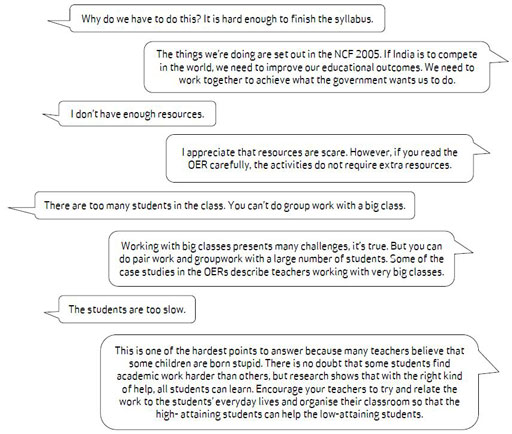
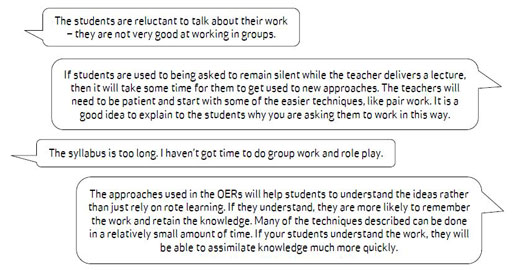
Resource 6: Reflection aid for teachers
Choose some of the questions below for discussion, depending on how much time you have.
- What challenges did I have while planning and preparing for this lesson?
- How did the pupils respond to the activities?
- What did my pupils learn and how do I know this?
- Were there differences in what they learned?
- Were the outcomes of the lesson achieved?
- What was I pleased about?
- What surprised me?
- What, if anything, was disappointing?
References
Acknowledgements
Except for third party materials and otherwise stated below, this content is made available under a Creative Commons Attribution-ShareAlike licence (http://creativecommons.org/ licenses/ by-sa/ 3.0/). The material acknowledged below is Proprietary and used under licence for this project, and not subject to the Creative Commons Licence. This means that this material may only be used unadapted within the TESS-India project and not in any subsequent OER versions. This includes the use of the TESS-India, OU and UKAID logos.
Grateful acknowledgement is made to the following sources for permission to reproduce the material in this unit:
Figure 6: © Fabrice Florin in Flickr (adapted) made available under: https://creativecommons.org/ licenses/ by-sa/ 2.0/ deed.en.
Figure 7: courtesy of Tide~ Global Learning, http://www.tidegloballearning.net/.
Every effort has been made to contact copyright owners. If any have been inadvertently overlooked the publishers will be pleased to make the necessary arrangements at the first opportunity.
Video (including video stills): thanks are extended to the teacher educators, headteachers, teachers and students across India who worked with The Open University in the productions.
